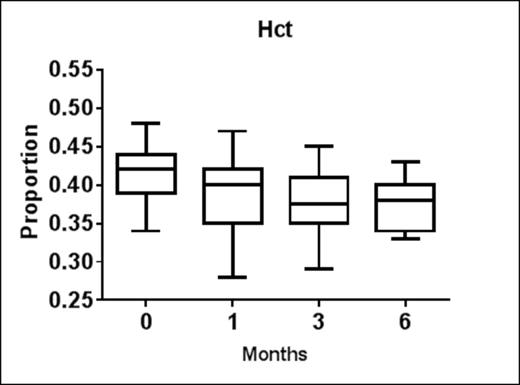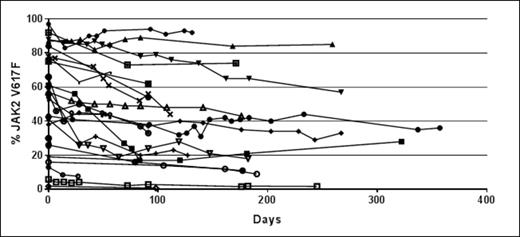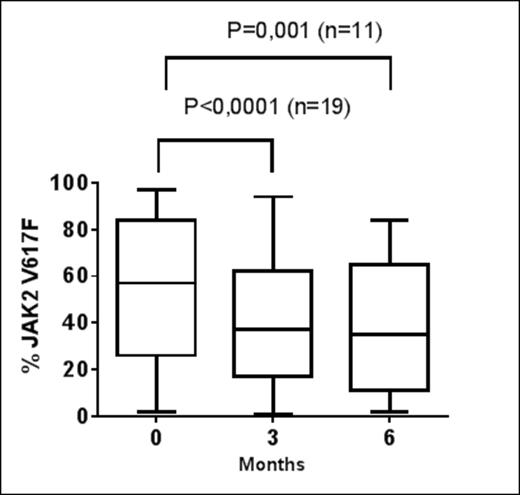Abstract
Background: The Philadelphia-negative, chronic myeloproliferative neoplasms (MPN) include essential thrombocythemia (ET), polycythemia vera (PV) and primary myelofibrosis (MF) (PMF). Chronic inflammation and a deregulated immune system are considered important for clonal evolution and disease progression. Ruxolitinib is a potent anti-inflammatory agent and has shown great benefit in MPN patients (pts), reducing spleen size and inflammation-mediated symptoms, thereby improving quality of life (QoL). Interferon-alpha2 (IFNa2) has been used successfully for decades in the treatment of MPN. However, 10-20% of pts are intolerant to IFNa2, yet others show limited response. Since concurrent inflammation might attenuate the efficacy of IFNa2 therapy, a combination therapy (CT) with the two agents may be more efficacious than monotherapy, likely reducing the inflammation-mediated adverse effects of IFNa2 as well. The purpose of this COMBI-trial is to evaluate the safety and efficacy of CT with IFNa2 and ruxolitinib.
Patients and Methods: At the time of data cutoff, a total of 30 pts ≥18 years with prefibrotic or hyperproliferative PMF (n=7), PV (n=20) or post-PV MF (PPV-MF) (n=3) with or without prior treatment with IFNa2 and without serious comorbidity were enrolled. Evidence of active disease was required. Initial therapy was IFNa2 45 μg x 1 sc/week (Pegasys®) or 35 μg x 1 sc/week (PegIntron®) + ruxolitinib (Jakavi®) 20 mg x 2/day. Efficacy was evaluated by internationally accepted clinicohematological response criteria, with the modification that splenomegaly was assessed by palpation instead of imaging, by week 2 and 1, 3, 6 and 9 months. In addition, JAK2V617F-allele burden was monitored. Adverse events (AE) including serious AE (SAE) were recorded.
Results: Median treatment duration was 24.4 weeks (range, 3.4 weeks-43.3 weeks). Twenty-seven pts were previously treated with IFNa2 (n=18 intolerant, n=5 unresponsive, n=4 both). Three pts were treatment-naïve. Twenty-seven pts (90%) remained on CT; 3 pts discontinued treatment due to an AE. One patient died from transformation to AML shortly after initiation of CT and was not included in this interim analysis. Marked improvements in pruritus, night sweats, and fatigue were recorded within the first 2-3 days in the large majority of pts and in all within 4 weeks. Palpable splenomegaly in 7 pts at baseline was significantly reduced by week 2. Hct control without phlebotomy was achieved by week 4 in 78 % of pts (7 of 9), who at baseline had an elevated hct. Only 3 pts required a total of 3 phlebotomies after initiation of CT. In Figure 1 median hct levels at 0, 1, 3, 6 months are shown.
Overall, complete response (CR) was achieved as best response in 19 pts (63.3%) and partial response (PR) or major response in 8 pts (26.7%). Only 3 pts (10%) had no response (NR) to treatment.
Among PV pts, 15 (75%) achieved CR (week 2, n=6; 1 month, n=6; 3 months, n=3). The other 5 PV pts achieved PR (week 2, n=3; 1 month, n=2). In PMF pts, CR (n=2) or major response (n=2) was achieved in 4 pts (57.1%) by week 2 or 1 month, and NR in 3 pts (42.8%). Among PPV-MF pts, 2 pts (66.7%) achieved CR and 1 patient (33,3%) PR by week 2.
Furthermore, JAK2V617F% declined significantly as depicted in Figure 2 (JAK2V617F% over time for each patient) and 3 (median JAK2V617F% at 0, 3, 6 months).
Anemia (n=15, 2 grade 3), granulocytopenia (n=13, 2 grade 3) or thrombocytopenia (n=6, 1 grade 3) were the most common AEs and were managed by dose reduction. One patient with PPV-MF (leuko- and thrombocytosis) developed pancytopenia within the first 2 weeks on CT, necessitating pausing medication for > 2 weeks. Eleven SAEs requiring hospitalization were recorded in 9 pts: pneumonia (n=3), fever (n=2), lipotymia, hematemesis, phlebitis, herpes zoster, angina pectoris and arterial hypertension, 1 patient each.
Conclusion: CT with IFNa2 and ruxolitinib is highly efficacious and safein pts with PV or hyperproliferative MF,who were unresponsive or intolerant to monotherapy with IFNa2. Complete clinicohematological responses were achieved in the majority of pts in concert with a reduction in the JAK2V617F-allele burden. In general, the treatment was well tolerated. The preliminary results from this study are highly promising, encouraging a prospective study with CT in newly diagnosed pts. Additional follow-up data will be presented including QoL assessment and the impact of concurrent treatment with statins.
Off Label Use: The combination therapy with ruxolitinib (JAK1-2 inhibitor) and interferon-alpha is off-label in MPNs. The concept is dual myelosuppressive action and dual clonal suppression in addition to the anti-inflammatory properties of ruxolitinib.. Bjørn:Novartis Oncology: Research Funding. Bjerrum:Bristoll Myers Squibb, Novartis and Pfizer: Other: educational activities. El Fassi:Novartis Denmark: Honoraria, Other: Have conducted an educational session for Novartis Denmark, regarding MPNs and ruxolitinib, for this a honorarium was received.. Nielsen:Novartis: Research Funding. Pallisgaard:Roche: Other: travel grant; Amgen: Membership on an entity's Board of Directors or advisory committees, Other: travel grant, Speakers Bureau; Novartis: Other: travel grant, Research Funding, Speakers Bureau; Qiagen: Membership on an entity's Board of Directors or advisory committees; Bristol Meyer Squibb: Speakers Bureau. Hasselbalch:Novartis: Research Funding.
Author notes
Asterisk with author names denotes non-ASH members.




This feature is available to Subscribers Only
Sign In or Create an Account Close Modal